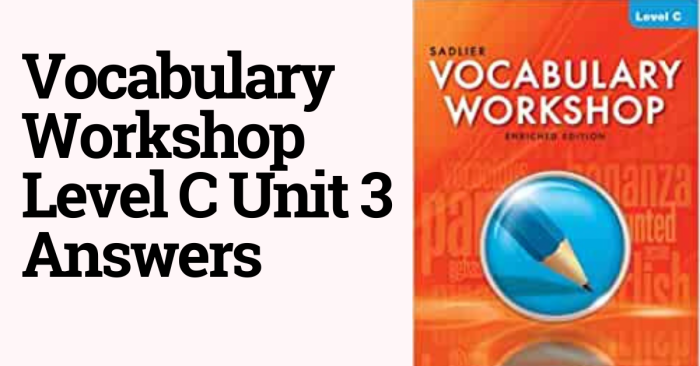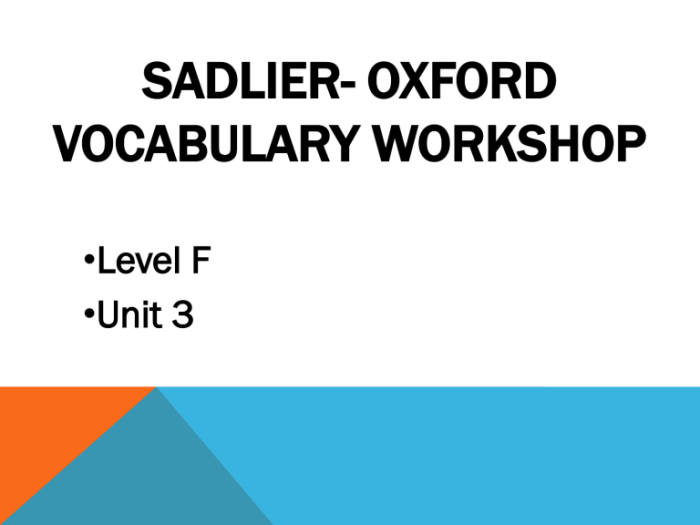Unit 3 level f completing the sentence – Unit 3 Level F Sentence Completion is a crucial skill for students to master, laying the foundation for effective communication and comprehension. This guide delves into the concept, assessment, and teaching strategies for sentence completion at this level, providing educators with a comprehensive understanding of this essential skill.
As students progress through their educational journey, sentence completion plays a vital role in developing their language proficiency, critical thinking abilities, and overall academic success.
Unit 3 Level F Completing the Sentence

Unit 3 Level F Sentence Completion focuses on developing students’ ability to complete sentences with appropriate words or phrases. This level builds on the skills learned in previous units, where students learned to identify and use different parts of speech.
At Unit 3 Level F, students are introduced to more complex sentence structures and are expected to use their knowledge of grammar and vocabulary to complete sentences accurately.
Incomplete Sentences
Incomplete sentences at this level typically consist of a subject, a verb, and a missing word or phrase that completes the thought.
- The boy ran quickly ____.
- The teacher asked the students ____.
- The car was parked ____.
Strategies for Teaching Sentence Completion, Unit 3 level f completing the sentence
There are several strategies that teachers can use to help students complete sentences accurately:
- Provide context:Give students a short passage or scenario to read before completing the sentences.
- Use visual aids:Use pictures or diagrams to help students visualize the sentence and identify the missing word or phrase.
- Use sentence frames:Provide students with a sentence frame, such as “The [subject] [verb] the [object] [adverb],” and have them fill in the missing words.
- Play games:Engage students in games that involve completing sentences, such as Mad Libs or fill-in-the-blank stories.
Assessment of Sentence Completion

Assessing students’ sentence completion skills is essential to monitor their progress and identify areas for improvement.
Methods for Assessment
There are several methods for assessing sentence completion skills:
- Formal assessments:These are typically timed tests that consist of a series of incomplete sentences.
- Informal assessments:These can be conducted during class time and may include observations, exit slips, or short quizzes.
Interpreting Assessment Results
When interpreting assessment results, teachers should consider the following:
- Accuracy:The number of sentences that students completed correctly.
- Consistency:The consistency with which students applied grammar and vocabulary rules.
- Complexity:The level of complexity of the sentences that students were able to complete.
Tips for Creating Effective Assessments
To create effective sentence completion assessments, teachers should:
- Use clear and concise language:The sentences should be easy to understand and should not contain ambiguous or unfamiliar words.
- Vary the sentence structures:Include a variety of sentence structures to assess students’ understanding of different grammatical concepts.
- Provide clear instructions:Explain to students what they are expected to do and how they will be graded.
al Strategies for Sentence Completion: Unit 3 Level F Completing The Sentence

Research-based al strategies can be effective in teaching sentence completion.
Differentiation
It is important to differentiate instruction for students with varying abilities. Some strategies for differentiation include:
- Providing scaffolding:Offer students support and guidance as they complete sentences.
- Using leveled materials:Provide students with materials that are appropriate for their skill level.
- Encouraging peer collaboration:Allow students to work together to complete sentences.
Lesson Plans and Activities
The following are examples of lesson plans and activities that focus on sentence completion:
- Sentence Completion Scavenger Hunt:Hide incomplete sentences around the room and have students search for them and complete them.
- Sentence Completion Mad Libs:Create a Mad Libs story and have students fill in the missing words.
- Sentence Completion Charades:Write incomplete sentences on slips of paper and have students take turns acting them out while their classmates guess the missing words.
Technology Tools for Sentence Completion
Technology tools can be used to support sentence completion in a variety of ways.
Specific Technology Tools
Some specific technology tools that can be used include:
- Online sentence completion exercises:There are many websites and apps that offer online sentence completion exercises.
- Speech-to-text software:This software can be used to record students’ sentences and then automatically transcribe them, allowing students to focus on completing the sentences rather than writing them.
- Interactive whiteboards:Interactive whiteboards can be used to display incomplete sentences and allow students to collaborate on completing them.
Integrating Technology Tools
To integrate technology tools into sentence completion lessons, teachers can:
- Use online exercises as homework assignments:This can help students practice sentence completion outside of class.
- Use speech-to-text software during class activities:This can help students focus on completing the sentences rather than writing them.
- Use interactive whiteboards to facilitate group work:This can allow students to collaborate on completing sentences and share their ideas.
Sentence Completion in Different Contexts

Sentence completion can be used in a variety of academic contexts.
Reading
Sentence completion can be used to assess students’ understanding of a text.
- Example:After reading a passage about the American Revolution, students could be asked to complete the sentence, “The American Revolution was fought for ____.”
Writing
Sentence completion can be used to help students develop their writing skills.
- Example:Students could be given a sentence starter, such as “The best day of my life was ____,” and asked to complete it.
Speaking
Sentence completion can be used to help students develop their speaking skills.
- Example:Students could be given a picture and asked to describe it using complete sentences.
Cross-Curricular Learning
Sentence completion can be used to promote cross-curricular learning.
- Example:In a science class, students could be given a sentence starter, such as “The process of photosynthesis is ____,” and asked to complete it using their knowledge of science.
Top FAQs
What is the significance of sentence completion at Unit 3 Level F?
Sentence completion at this level is essential for developing students’ grammatical knowledge, vocabulary, and comprehension skills, enabling them to express themselves effectively and understand written text.
How can I assess students’ sentence completion abilities?
Assessment methods include timed exercises, cloze passages, and oral sentence completion tasks. Analysis of results helps identify areas for improvement and tailor instruction accordingly.
What strategies can I use to teach sentence completion effectively?
Effective strategies include providing sentence frames, using visual aids, and incorporating games and activities. Differentiated instruction ensures that all students receive appropriate support and challenges.